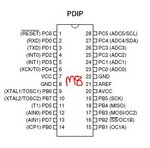anishd19
Newbie level 5
I, by mistake, forgot to remove LCD from microcontroller (ATmega8A) while programming. The LCD is totally bricked. Is there a way to recover my LCD?
I tried google and even searched our forum. Please help me ASAP, I need it for my review of final year project tomorrow. Brand new it is!! :/
I tried google and even searched our forum. Please help me ASAP, I need it for my review of final year project tomorrow. Brand new it is!! :/

